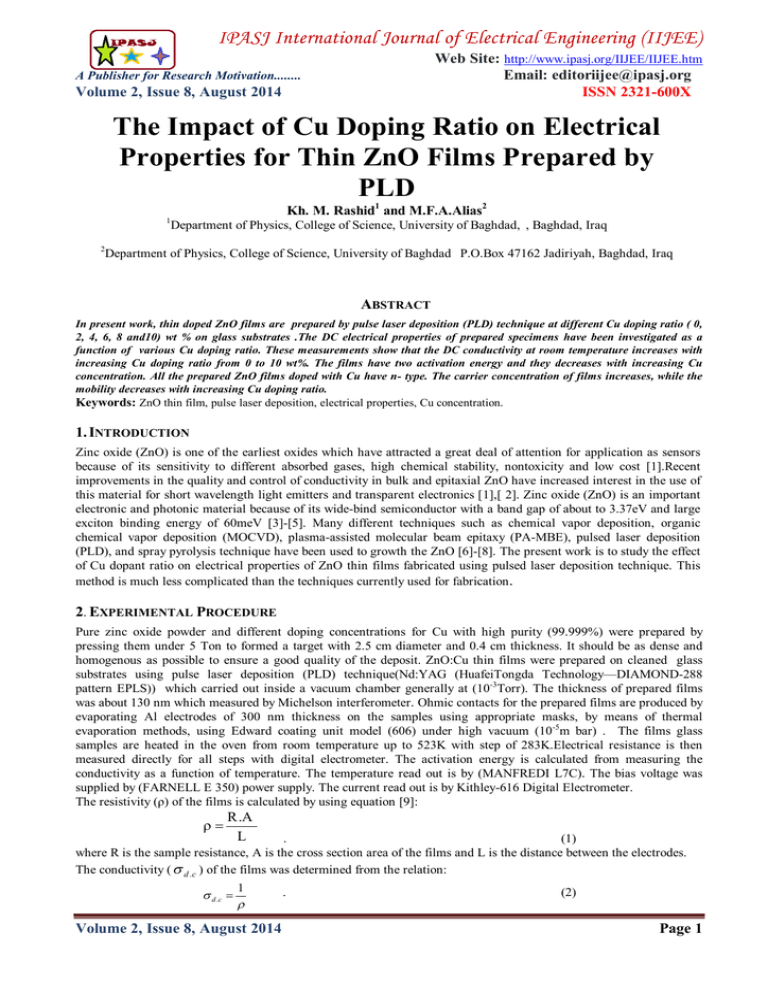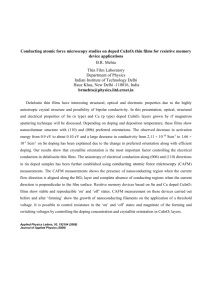Full Text
advertisement

IPASJ International Journal of Electrical Engineering (IIJEE) Web Site: http://www.ipasj.org/IIJEE/IIJEE.htm Email: editoriijee@ipasj.org ISSN 2321-600X A Publisher for Research Motivation........ Volume 2, Issue 8, August 2014 The Impact of Cu Doping Ratio on Electrical Properties for Thin ZnO Films Prepared by PLD Kh. M. Rashid1 and M.F.A.Alias2 1 2 Department of Physics, College of Science, University of Baghdad, , Baghdad, Iraq Department of Physics, College of Science, University of Baghdad P.O.Box 47162 Jadiriyah, Baghdad, Iraq ABSTRACT In present work, thin doped ZnO films are prepared by pulse laser deposition (PLD) technique at different Cu doping ratio ( 0, 2, 4, 6, 8 and10) wt % on glass substrates .The DC electrical properties of prepared specimens have been investigated as a function of various Cu doping ratio. These measurements show that the DC conductivity at room temperature increases with increasing Cu doping ratio from 0 to 10 wt%. The films have two activation energy and they decreases with increasing Cu concentration. All the prepared ZnO films doped with Cu have n- type. The carrier concentration of films increases, while the mobility decreases with increasing Cu doping ratio. Keywords: ZnO thin film, pulse laser deposition, electrical properties, Cu concentration. 1. INTRODUCTION Zinc oxide (ZnO) is one of the earliest oxides which have attracted a great deal of attention for application as sensors because of its sensitivity to different absorbed gases, high chemical stability, nontoxicity and low cost [1].Recent improvements in the quality and control of conductivity in bulk and epitaxial ZnO have increased interest in the use of this material for short wavelength light emitters and transparent electronics [1],[ 2]. Zinc oxide (ZnO) is an important electronic and photonic material because of its wide-bind semiconductor with a band gap of about to 3.37eV and large exciton binding energy of 60meV [3]-[5]. Many different techniques such as chemical vapor deposition, organic chemical vapor deposition (MOCVD), plasma-assisted molecular beam epitaxy (PA-MBE), pulsed laser deposition (PLD), and spray pyrolysis technique have been used to growth the ZnO [6]-[8]. The present work is to study the effect of Cu dopant ratio on electrical properties of ZnO thin films fabricated using pulsed laser deposition technique. This method is much less complicated than the techniques currently used for fabrication. 2. EXPERIMENTAL PROCEDURE Pure zinc oxide powder and different doping concentrations for Cu with high purity (99.999%) were prepared by pressing them under 5 Ton to formed a target with 2.5 cm diameter and 0.4 cm thickness. It should be as dense and homogenous as possible to ensure a good quality of the deposit. ZnO:Cu thin films were prepared on cleaned glass substrates using pulse laser deposition (PLD) technique(Nd:YAG (HuafeiTongda Technology—DIAMOND-288 pattern EPLS)) which carried out inside a vacuum chamber generally at (10-3Torr). The thickness of prepared films was about 130 nm which measured by Michelson interferometer. Ohmic contacts for the prepared films are produced by evaporating Al electrodes of 300 nm thickness on the samples using appropriate masks, by means of thermal evaporation methods, using Edward coating unit model (606) under high vacuum (10-5m bar) . The films glass samples are heated in the oven from room temperature up to 523K with step of 283K.Electrical resistance is then measured directly for all steps with digital electrometer. The activation energy is calculated from measuring the conductivity as a function of temperature. The temperature read out is by (MANFREDI L7C). The bias voltage was supplied by (FARNELL E 350) power supply. The current read out is by Kithley-616 Digital Electrometer. The resistivity (ρ) of the films is calculated by using equation [9]: R .A L . (1) where R is the sample resistance, A is the cross section area of the films and L is the distance between the electrodes. The conductivity ( d .c ) of the films was determined from the relation: d .c 1 Volume 2, Issue 8, August 2014 . (2) Page 1 IPASJ International Journal of Electrical Engineering (IIJEE) A Publisher for Research Motivation........ Volume 2, Issue 8, August 2014 Web Site: http://www.ipasj.org/IIJEE/IIJEE.htm Email: editoriijee@ipasj.org ISSN 2321-600X The activation energies (Ea) could be calculated from the plot of lnσ versus 1000/T using the equation[9]: Ea d .c o exp K BT (3) Hall Effect measurement has been done by Van der Pauw (Ecopia HMS-3000) Hall Measurement Systems by a magnetic field (B=0.550 Tesla) applied perpendicular to the Hall element. The carrier concentration (n) is related to the Hall coefficient (RH) which is given by RH 1 qn (4) The Hall mobility (H) can be found from relation between Hall coefficient and conductivity ()[10]. H RH nq (5) 3. RESULTS AND DISCUSSION Figure (1) shows the variation of Ln (σ) with reciprocal temperature for deposited ZnO films with different Cu doping ratio (0, 2, 4, 6, 8 and 10) wt%. This figure shows that all films have two activation energies and these activation energies decrease with increasing doping ratio ,i.e, it decreases about four times for Ea1 ( 0.222 - 0.057 ) eV and nearly five times for Ea2 (0.593 - 0.127) eV when the Cu ratio vary from 0 to 10%. This result may due to decrease energy gap with the increase of doping ratio. All these values have been listed in Table (1). These results are in agreement with Yoon et al.[11] and Bouhssira et al.[12]. Figure 1 Variation of Ln (σ) with reciprocal temperature for deposited thin ZnO films at different Cu doping ratio. Figure 2 Variation of DC activation energies with Cu doping ratio for thin ZnO films. Volume 2, Issue 8, August 2014 Page 2 IPASJ International Journal of Electrical Engineering (IIJEE) Web Site: http://www.ipasj.org/IIJEE/IIJEE.htm Email: editoriijee@ipasj.org ISSN 2321-600X A Publisher for Research Motivation........ Volume 2, Issue 8, August 2014 Figure 3 Variation of DC conductivity at room temperature with Cu doping ratio for thin ZnO films. Table 1 DC activation energies, their ranges and conductivity at room temperature for thin ZnO films at different Cu doping ratio Cu% σRT (Ω.cm) -1 Ea1 (eV) 0 2 4 6 8 10 6.55*10-7 5.04*10-6 5.72*10-5 1.20*10-4 2.98*10-4 1.20*10-3 0.222 0.114 0.094 0.083 0.035 0.057 Range of Temp.(K) 293-373 293-373 293-373 293-373 293-373 293-373 Ea2 (eV) Range of Temp. (K) 373-473 373-473 373-473 373-473 373-473 373-473 0.593 0.519 0.254 0.230 0.172 0.127 n*1015 (cm-3) The Hall measurements indicates that the pure ZnO and ZnO:Cu films were n-type, this goes in agreement with the previous work [13]. (Hall voltage values decrease when the current increases). Figures (4 and 5) show the variation of n carrier concentration and mobility (μH) with different Cu dopant ratio. The values of RH , n and μH at different doping ratio of Cu are given in Table (2). It is seen that n value increases with increasing Cu doping ratio, while the Hall mobility (μH) of the ZnO:Cu films decreases with increasing doping ratio. This behavior is expected as a result of the substitution doping of Cu 2+ site creating one extra free carrier in the process. As the doping level is increased, more dopant atoms occupy lattice sites of zinc atoms resulting in more charge carriers. Thus, the conductivity increases with increasing dopant ratio [14]. The ZnO film generally grows as an n-type semiconductor, due to the presence of native defects in the form of zinc interstitials, oxygen vacancies, or both. A decrease in μH with dopant ratio may be due to impurity scattering from the substitution donors and scattering from the interstitials and decreasing grain size which leads to increase grain boundaries [15]. 0 5 doping% 10 15 Figure 4 Variation of carrier concentration (n) with different dopant ratio for thin ZnO films . Volume 2, Issue 8, August 2014 Page 3 IPASJ International Journal of Electrical Engineering (IIJEE) Web Site: http://www.ipasj.org/IIJEE/IIJEE.htm Email: editoriijee@ipasj.org ISSN 2321-600X A Publisher for Research Motivation........ Volume 2, Issue 8, August 2014 Figure 5 Variation of mobility (μ) with different dopant ratio for thin ZnO films. Table 2 Hall measurements of ZnO thin films prepared at different Cu dopant ratio Cu % RH (cm3/c) nH (cm-3) μH (cm2/V.sec) type 0 -1.20*108 5.00 *1010 78.6 n 2 -1.20*10 7 5.20*1011 60.5 n -8.50*10 5 7.35*10 12 48.6 n 6 -2.60*10 5 2.40*10 13 31.2 n 8 -5.40*104 1.16*1014 16.1 n 14 09.0 n 4 10 -75*10 3 8.00*10 4. CONCLUSIONS Electrical properties of pure and Cu doped thin ZnO films deposited by pulse laser deposition technique have been studied as a function of different Cu dopant ratio. The outcome of this investigation can be summarized as follows: Pure and doped ZnO films have two activation energies and with increasing doping ration these activation energies decrease while the conductivity decreases. Hall Effect measurements show that all films have n- type charge carriers and its concentration increases whereas the mobility decreases with increasing doping ratio. REFERENCES [1] D. Look, "Recent advances in ZnO materials and devices". Materials Science and Engineering B,80, pp.383387,2001. [2] M.F.A.Alias, R.M.Aljarrah , H.Kh.Al-Lamy and K.A.W.Adem ,"Investigation the Effect of Thickness on the Structural and Optical Properties of Nano ZnO Films Prepared by d.c Magnetron Sputtering", International Journal of Application or Innovation in Engineering and Management (IJAIEM) ,2(7) pp.198-203,2013. [3] A.D.A. Buba and J.S.A. Adelabu, Optical and Electrical Properties of Deposited ZnO Thin Films, The pacific Journal of Science and Technology,11,pp. 429-434,2010. [4] D. CornejoMonroy, J.F. Sanchez-Ramirez, M. Herrera-Zaldivar and U. Pal, “Effect of Deposition Parameters on the Optical and Microstructure Characteristics of Sputtered deposited Nanocrystalline ZnO Thin Films”, Revista Mexicana De Fisica. 53,pp.23-28 ,2007. [5] R.Sharma, P.K. Shishodia, A. Wakahara and R.M. Mehra,”Investigations of Highly Conducting and Transparent Sc Doped ZnO Films Grown by the Sol-gel process”, Materials Science- Poland, 27,pp. 225-237,2009. Volume 2, Issue 8, August 2014 Page 4 IPASJ International Journal of Electrical Engineering (IIJEE) A Publisher for Research Motivation........ Volume 2, Issue 8, August 2014 Web Site: http://www.ipasj.org/IIJEE/IIJEE.htm Email: editoriijee@ipasj.org ISSN 2321-600X [6] Y.F.Mei, G.G.Siu, Ricky K.Y.Fu, Paul K.Chu,Z.M. Li, Z.K. Tang, “Room-temperature Electro synthesized ZnO Thin Film with Strong (002) Orientation and its Optical Properties”, Applied Surface Science,252,pp. 29732977,2006. [7] B. J. Lokhande, M.D.Uplane, “Structural, Optical and Electrical Studies on Spray Deposited Highly Oriented ZnO Films”, Applied Surface Sciences, 167, pp. 243-246, 2000. [8] T.C.Zhang, Y.Guo, Z.X.Mei, C.Z.Gu, and X.L.Du,” Visible-blind Ultraviolet Photodetector Based on Double Heterojunction of n-ZnO / Insulator –Mg/p-Si”, Applied Physics Letters.94,pp.113508/1-3,2009. [9] B. Stereeman, Solid State Electronic Devices, 2nd Ed, Practice Hall, Inc. Engle Wood Cliffs, N.J. 1980. [10] A.Islam, M.Islam ,M.Choudhury and M.Hossan, "Recent Development in Condensed Matter Physics and Nuclear Science", Rajshahi University, Bangladesh,1969. [11] K. Yoon, J.Choi and D. Lee, “Characteristics of ZnO Thin Films Deposited onto Al/Si Substrates by r.f. Magnetron Sputtering” ,Thin Solid Film, 302,pp.116-121, 1997. [12] N. Bouhssira, S. Abed, E. Tomassella, J. Cllier M. Aida and M. Jecquet,” Influence of Annealing Temperature on the Properties of ZnO Thin Films Deposited by Thermal Evaporation", Applied Surface Science, 252, pp.55945597 ,2006. [13] A. Tsukasaki, A. Ohtomo, T. Onuma, M. Ohtani, M. Sumiya, S. Fuke, Y. Segawa, H. Ohno, H. Koinuma, and M. Kawasaki. "Repeated Temperature Modulation Eepitaxy for p-type Doping and Light Emitting Diode Based on Zinc-Oxide." Nature Materials,4, pp. 42-46, 2005. [14] M. Kashkol. , "Study of the Sensing Properties of the Aluminum- Doped Zinc Oxide Thin Films Prepared by Thermal Vacuum Evaporation Technique", University of Mustansiriya, Ph.D. Thesis, (2009). [15] P. Sagar, M. Kumar and R. M. Mehra, "Electrical and Optical Properties of Sol-Gel Derive ZnO: Al Thin Films", Materials Science-Poland, 23( 3),pp.685-696,2005. Volume 2, Issue 8, August 2014 Page 5
